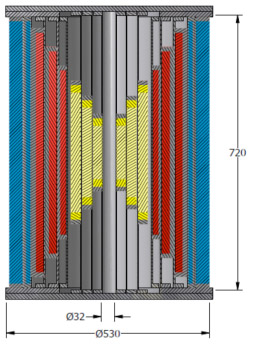

The National High Magnetic Field Laboratory has been awarded nearly $3 million to build a novel kind of superconducting magnet that will break records for magnetic field strength, make possible new types of science and save vast amounts of energy and money.
The magnet, funded by a National Science Foundation grant of $2 million and a matching award from The Florida State University of $1 million, is projected to generate a magnetic field of 32 tesla. (Tesla is the scientific unit of measure of magnetic field strength.) That is more than 3,000 times stronger than a typical refrigerator magnet, and about 45 percent more powerful than the strongest superconducting magnets available today.
As impressive as that sounds, it is just the tip of the scientific iceberg. The material that will be used for this magnet, a type of high-temperature superconductor called yttrium barium copper oxide, or YBCO, promises to revolutionize research in high magnetic fields. About 5 miles of YBCO cable will go into the new magnet.
Superconducting magnets have been powering hospital MRI machines for decades (at about 1 to 3 tesla) and are commonly used in high-field research. They are valuable in part because they are made with special superconducting materials that conduct electricity without any friction, and therefore use very little electricity. Non-superconducting electromagnets, called resistive magnets, consume massive amounts of electricity. At the magnet lab, the average cost to run a resistive magnet is $774 per hour — 40 times more than a 20-tesla superconducting magnet.
One of the downsides to superconducting magnets is that the materials they are built with work only at temperatures so low that expensive cryogens, such as liquid helium, are needed to operate them. Also, traditional superconducting materials stop working inside a magnetic field above about 23 tesla, so resistive magnets have always been able to outperform them.
But YBCO oversteps both these hurdles. It belongs to a class known as high-temperature superconductors. These materials perform at much higher temperatures than their "low-temperature" cousins, making them more practical and cheaper to operate — and they continue to operate beyond the point at which low-temperature superconductors cease working. Another huge benefit: Superconducting magnets create more stable magnetic fields than resistive magnets, which produce better data for scientists. All of this means the 32-tesla project will be the first of a whole new generation of powerful, low-cost superconducting magnets.
William Denis Markiewicz, a scholar/scientist at the magnet lab, is the principal investigator on the project. He foresees the day when the lab's existing lineup of resistive magnets becomes obsolete.
"The objective is to develop and demonstrate the technology that can be used in magnets that will eventually replace the resistive magnets in our facility," said Markiewicz, a veteran engineer at the lab whose design achievements include the lab's world-record 900 megahertz, ultra-wide-bore superconducting magnet. "The advantages that will follow include lower operating costs and quieter field conditions for the scientist."
To have 32 tesla, at such high quality, for such a bargain price will be nothing less than a boon for physics, said Stephen Julian, a University of Toronto physicist who sits on the magnet lab's External Advisory Board and is a co-principal investigator on the grant.
"This magnet opens up new possibilities for measurements that we have previously only dreamed of," Julian said. "With these new magnets, researchers will be able to stay at these very high magnetic fields for as long as they like. This will dramatically increase the quality of data for many measurements. We can look forward to breakthroughs in biomedical magnetic resonance imaging, studies of protein structure, semiconductor physics and the physics of metals."
Perhaps most fittingly, the new magnet, which is scheduled for completion in 2012, will advance high-temperature superconductor research.
"We're going to be using high-temperature superconductors to understand high temperature superconductors, and that seems quite fun," Julian said.
Read more about the NSF grant at www.nsf.gov.
- 2015: An Unforgettable Year for Florida State
- Faculty member receives 2015 Dance Magazine Award
- Professor featured in 2016 National Education Technology Plan
- Kiplinger's names FSU a 'best value'
- New physician assistant program names founding director
- Recent FSU graduates receive Directors Guild of America Awards
- FSU receives national recognition for undergraduate research achievements
- President Thrasher sees a transformational year ahead for FSU
- How to support FSU shooting victim

